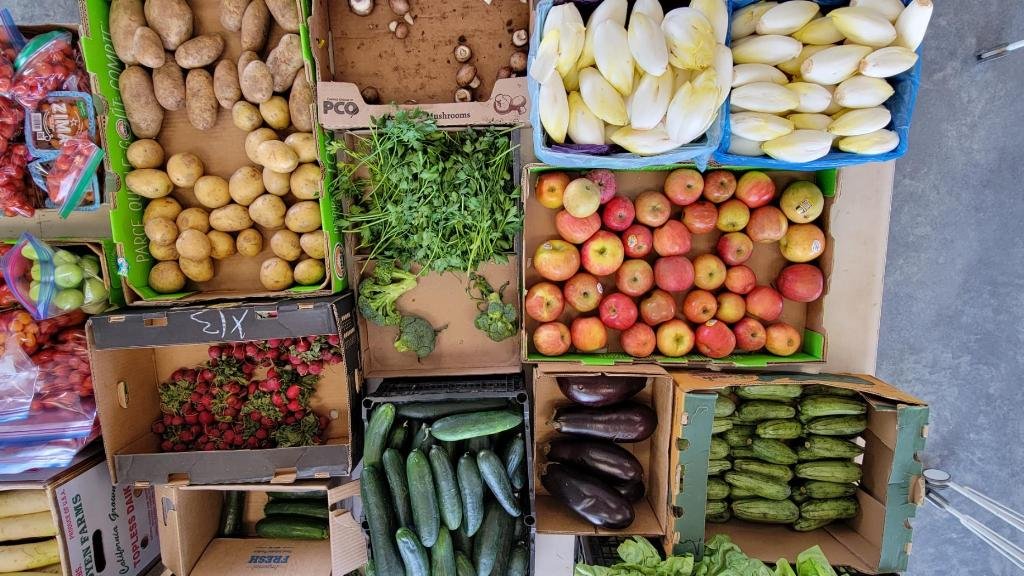By Catherine Webber
How do huge grocery stores play a role in the mission to more equitably distribute food? This is a relatively complicated question and one I found myself asking as soon as I became involved with Food to Power’s goals.
To better understand how food is distributed (and often wasted along the way), let’s start all the way at the beginning of the food supply chain with the farmers. Grocery stores in the US have very specific requirements for the quality of food they receive from farmers. This means any vegetables that aren't shaped “right” won’t make it from the farmer to the next step in the distribution chain. Most of the food in the US then moves to a holding facility of sorts. This is an interesting choice as this step also allows for fresh food to sit for longer and some of it inevitably goes bad, resulting in more waste. When the time is right, the food will be transported to grocery stores and have the potential to be bought by consumers.
Rachel Followill holds a funny pumpkin. This one probably wasn’t rejected for its shape, but many vegetables are!
This is the step in the chain where Food to Power, and other similar organizations, hope to utilize the food found in these grocery stores. Many times, grocery stores order too much food. This overabundance can lead to waste and disposal in the landfill. Through the food recovery program, Food to Power offers another option: donate the food that is still fit to be consumed, and the food will be redistributed at no cost to people who face challenges in accessing food. Through this additional step, food goes from where it’s overly abundant and wasted to where it’s truly needed and enjoyed.
While the steps leading up to this point reflect a flawed system, the opportunity for redistribution, holds immense potential and must be seen as a tool. The distribution networks of large grocery stores have power that can be harnessed and used for good by local organizations. Effective food recovery from large grocery stores is a main focus of Food to Power’s work.
Some stores do a better job of screening produce before donation - this broken green bell pepper needed to be added to food scrap collections for compost.
Food to Power cultivates relationships with these stores and have a mutually beneficial partnership. Through such partnerships, stores provide nutritious food options to Food to Power and the store receives a tax exemption for this generosity. Rachel Followill, Director of Food Access, spoke to some of the challenges in this process such as food safety awareness and disconnects between the suppliers/grocery stores and consumers. “[It] takes a lot of time and building of trust and in addition there's food safety pieces… like what is edible food and what should and shouldn't be donated.” A relationship has to be built directly with the manager of a store and that relationship then has to be maintained. Rachel added that if the manager then leaves their job, Food to Power often has to start the relationship with the grocery store over from ground zero.
Ideally Food to Power would receive daily donations of edible and delicious food from these grocery stores that could be redistributed to the community. In reality, there are ups and downs in donation rates and grocery stores aren't always aware of what they should and should not be sending. Rachel has also noticed that as food availability shifts with market factors such as COVID-19, food shortages, and more, donations shift accordingly, this can lead to surprisingly large amounts of some things and huge lack of others.
In addition to working with national level grocery stores and local producers, Food to Power works with Feeding America. Feeding America is an intermediary between the grocery stores and local redistribution networks like Food to Power. The local branch of Feeding America is called Care and Share. Feeding America’s overall model is forming relationships with grocery stores and producers and stockpiling food into storage facilities. The relationship between Feeding America and Food to Power hasn't always been seamless because Feeding America’s national policies often include exclusive contracts with local grocery stores. These exclusive contracts mean that grocery stores can only send donations to Care and Share, as the local branch of Feeding America. Though these contracts have caused some tension, the local team at Care and Share is committed to creating food equity for all and supports Food to Power’s mission in food distribution. This has created a positive relationship, and this relationship will continue to grow as more people become invested in the concerns of food equity.
Food Recovery holds the power to bring a wide variety of fresh, healthy foods back where it’s needed!
Looking to the future Food to Power is hoping to expand its capacity in terms of food movement and collection. Rachel is looking to cultivate more lucrative donor relationships to further increase the amount of food available to distribute. From there, a larger volunteer base will be necessary to add to the knowledge and support within the organization. Food to Power is also researching steps to create a community-owned grocery store - stay tuned!




